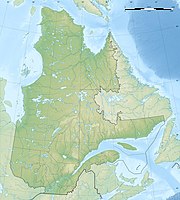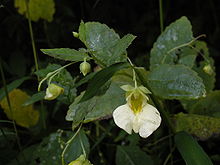Réserve écologique du Micocoulier
|
Réserve écologique du Micocoulier
|
||
| location | Vaudreuil-Soulanges , Québec, Canada | |
| surface | 0.29 km² | |
| WDPA ID | 5078 | |
| Geographical location | 45 ° 27 ′ N , 74 ° 0 ′ W | |
|
|
||
| Setup date | 1981 | |
| administration | MDDEP | |
The Réserve écologique du Micocoulier is an ecological reserve in the south of the Canadian province of Québec in the regional county municipality of Vaudreuil-Soulanges .
The reserve was established in 1981 on an area of 28.73 hectares and includes the two islands Arthur and Bienville in the Saint Lawrence River in the municipality of Saint-Ignace-du-Coteau-du-Lac . The western hackberry tree ( Celtis occidentalis ), which has become rare in Québec, is the focus of conservation efforts.
The subsoil consists mainly of sandstone and dolomite. Above are sediments deposited by the river. Tillit is found in the higher elevations, deposits from the Champlain Sea era in the middle elevations and in the lower alluvial areas. While the two higher layers drain well, this is not possible in the lower layers. The ostrich fern , which in Québec is called matteuccie fougère-à-l'autruche or fougère allemande ('ostrich' or 'German fern'), the hooded heart flower ( Dicentra cucullaria ), Impatiens pallida from the, is found in the well-draining layers Genus of spring herbs , the poisonous yellowwood dogwood ( Cornus stolonifera ), Ageratina altissima , which is called eupatoire rugueuse in Québec . The latter belongs to the tribe of the Eupatorieae from the subfamily of the Asteroideae , which in turn belongs to the sunflower family . In the wetter, poorly draining areas, Onoclea sensibilis from the Onocleaceae family , which belongs to the class of the real ferns , and the red elm are more dominant , in addition there are cane grass (French: phalaris roseau) and the common loosestrife , especially on sandy terrain ( Lythrum salicaria , French: salicaire pourpre). Polygonum punctatum , the leaves of which are edible, thrive in a small hollow of wet tillits.
A total of 115 vascular plants and a further 26 non-vascular plants are recorded in the protected area. Four of these species are endangered or threatened, namely Cardamine concatenata from the genus of the foamy herbs , Carex alopecoidea from the genus of sedges , Floerkea proserpinacoides Willdenow , which is called Floerkée fausse-proserpinie in Québec and belongs to the Limnanthaceae family , and the American pimpernut ( Staphyleae trifolia ) from the genus of the pimpernuts (Staphylea). Forest garlic (Ail des bois) and American ginseng ( Panax quinquefolius ; French: ginseng américain or ginseng à cinq folioles ) are similarly endangered .
There is a small heron colony of six to eight nests on the islands. The mammals include the deer vole , here called Souris sylvestre , the field mouse ( Microtus arvalis ), the muskrat, squirrels and raccoons that have been observed.
Web links
- Réserve écologique du Micocoulier , government website
Remarks
- ↑ Floerkée fausse-proserpinieFloerkée fausse-proserpinie , Développement durable, Environnement et Parcs Québecs.






